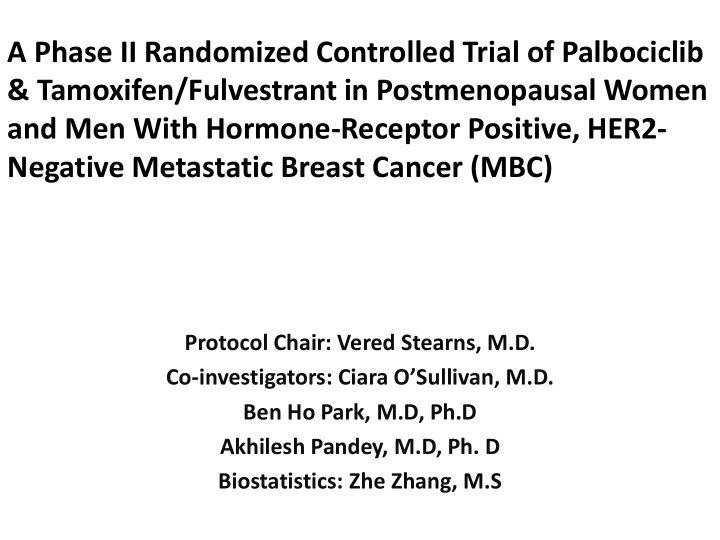



A Phase II Randomized Controlled Trial of Palbociclib & Tamoxifen/Fulvestrant in Postmenopausal Women and Men With Hormone-Receptor Positive, HER2- Negative Metastatic Breast Cancer (MBC) Protocol Chair: Vered Stearns, M.D. Co- investigators: Ciara O’Sullivan, M.D. Ben Ho Park, M.D, Ph.D Akhilesh Pandey, M.D, Ph. D Biostatistics: Zhe Zhang, M.S
Background • Despite new targeted therapies, approx. 40,000 women will die of MBC in the US in 2014 • 75% of MBC is hormone receptor (HR)-positive (ER+ and/or PR+) • Endocrine therapy (ET) is cornerstone of treatment, but all pts progress & few cured due to development endocrine resistance. • 35-40% patients have HR+HER2- disease & are not eligible for HER2-directed therapies. • Renewed interest in combining chemo/experimental therapies with ET to overcome endocrine resistance & expand treatment options • Recent strategies: addition of mTOR inhibitors and cyclin-dependent kinase 4/6 inhibitors (CDK4/6i), e.g. palbociclib
Mechanism Of Action of Palbociclib & PFS Benefit • Doubling of PFS noted in PALOMA-1 trial (Palbociclib & letrozole vs. letrozole alone): 20.2 months vs .10.2 months • Minimal toxicity
Study Hypothesis • Eligible patients with HR-positive, HER2- negative MBC treated with palbociclib and tamoxifen/fulvestrant have a significant improvement in PFS vs. patients treated with tamoxifen /fulvestrant alone. • The presence/absence of ER mutations may be a predictive biomarker of response to treatment.
Study Schema
Study Objectives Primary • Compare PFS in postmenopausal women and men with ER- positive, HER2-negative MBC treated with tamoxifen /fulvestrant and palbociclib vs. tamoxifen /fulvestrant alone in pts who have progressed on at least one line of endocrine therapy in the metastatic setting Secondary • Compare measures of disease control, including response rate (RR), and clinical benefit rate (CBR) between treatment arms. • Compare safety and tolerability between treatment arms
Correlative Objectives Exploratory • Prospectively follow plasma tumor DNA levels in patients • Describe alterations in genes and gene products relevant to the cell cycle, drug targets, tumor sensitivity and resistance • Aim to identify several pathway markers that are predictive of response to CDK4/6 inhibition, considering variables such as ER mutational status, ER- positivity and phosphoproteomics .
Correlates • New/fresh biopsies of metastatic site – Baseline/Pre-treatment – for confirmation of ER+HER2- MBC – Surgical specimen • Study bloods – Pharmacogenomics (optional) – ptDNA levels (baseline, after every 2 cycles (i.e. 8 week intervals) – PKs (1 and 2 hours post-dose on day 1, pre-dose weeks 4/7/10) • Imaging – All patients must receive restaging CT CAP every 2 cycles (i.e.8 week intervals)
Inclusion Criteria • Postmenopausal females & • CNS mets allowed if treated ≥ men 4 wks from starting study drug • Stage IV breast cancer & have recovered from • toxicities ER and/or PR-positive • • Disease free of invasive Evaluable/measurable disease malignancies ≥ 5 years (except by RECIST 1.1 BCC/ SCC skin or CIN) • ECOG 0-2 • Bisphosphonates allowed if • Progressed on at least one line started before trial entry of prior ET in the metastatic • If baseline biopsy cannot be setting obtained, pt is still eligible for • Use adjuvant TAM/ aromatase trial inibitor permitted (stopped >6 months prior to devt MBC) • Adequate end organ function
Exclusion Criteria • Concurrent CYP2D6 • Uncontrolled intercurrent inhibitors illness (moderate/strong)* • Pts developing MBC • Inhibitors/inducers of within 6 months of CYP3A4 adjuvant tx • Medications that prolong • Pts who have had more QTc than one line of prior • Medical/Psych treatment for MBC comorbidities affecting (chemo,hormones, compliance or posing experimental therapy). increased risk to pt • Other current experimental therapy
Statistical Plan & Study Design • Non-blinded, randomized phase II study • 3:1 randomization to palbociclib and tamoxifen/fulvestrant vs. tamoxifen/fulvestrant alone (n=100; 70-80 pts P & T, 20-30 pts T ) • 28 day cycle - Tamoxifen 20mg orally daily / Fulvestrant 500mg loading dose, then 250mg I.M monthly - Palbociclib 125mg orally days 1-21, then 7 days off • Patients on tamoxifen/fulvestrant alone arm can cross over to palbociclib at progression
Significance • The combination of palbociclib and letrozole has already shown to double PFS in patients with HR-positive, HER2-negative MBC who have already progressed on one prior line of ET. • Therefore, CDK4/6 inhibitors are very promising agents in the treatment of this subgroup of patients given these impressive results and the favorable toxicity profile. • This trial will evaluate the efficacy of other ET/palbociclib combinations in this setting and aim to identify predictive biomarkers of treatment response.
Recommend
More recommend